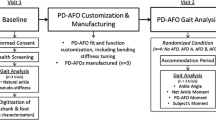Abstract
Patients with muscle atrophy undergo rehabilitation exercises by applying resistive force and obstructing foot movement to strengthen their muscles and engage with their neuromuscular system. This can be successfully accomplished without the intervention of a physiotherapist through the use of passive wearable ankle-foot exoskeleton. The existing devices in the market cannot offer bidirectional and variable resistance rehabilitation. This paper proposes the design and development of a passive ankle rehabilitation exoskeleton for bidirectional resistance training with variable stiffness element for ankle torque variation. The conceptual design of the exoskeleton with a variable stiffness element made of Grade 5 Titanium alloy (Ti6Al4V) has been presented along with its kinematic and static analysis. The fabricated prototype of the device was validated using surface electromyogram (sEMG), and the observation clearly depicted improvement in the signal energy during plantar flexion and dorsiflexion.
Access this chapter
Tax calculation will be finalised at checkout
Purchases are for personal use only
Similar content being viewed by others
References
Enderle, J., Bronzino, J. (eds.): Introduction to Biomedical Engineering. Academic Press, Cambridge (2012)
Engsberg, J.R., Grimstom, S.K., Hanley, D.A.: Differences in ankle joint complex range of motion as a function of age. Foot Ankle 14(4), 215–222 (1993)
Hiller, C.E., et al.: Prevalence and impact of chronic musculoskeletal ankle disorders in the community. Arch. Phys. Med. Rehabil. 93(10), 1801–1807 (2012)
Zhang, M., Davies, T.C., **e, S.: Effectiveness of robot-assisted therapy on ankle rehabilitation–a systematic review. J. Neuroeng. Rehabil. 10(1), 1–16 (2013)
Yu, H., et al.: Mechanical design of a portable knee-ankle-foot robot. In: IEEE International Conference on Robotics and Automation, pp. 2183–2188. IEEE (2013)
Wang, X., Guo, S., Qu, B., Song, M., Qu, H.: Design of a passive gait-based ankle-foot exoskeleton with self-adaptive capability. Chin. J. Mech. Eng. 33(1), 1–11 (2020)
Alvarez-Perez, M.G., Garcia-Murillo, M.A., Cervantes-Sánchez, J.J.: Robot-assisted ankle rehabilitation: a review. Disabil. Rehabil. Assist. Technol. 15(4), 394–408 (2020)
Guler, K., Petrisor, D.M.: A Pugh Matrix based product development model for increased small design team efficiency. Cogent Eng. 8(1), 1923383 (2021)
Suga, T., et al.: Calcaneus height is a key morphological factor of sprint performance in sprinters. Sci. Rep. 10(1), 1–10 (2020)
Freudenstein, F.: Design of Four-Link Mechanisms. Columbia University (1954)
Mizuno, S., Sonoda, S., Takeda, K., Maeshima, S.: Measurement of resistive plantar flexion torque of the ankle during passive stretch in healthy subjects and patients with poststroke hemiplegia. J. Stroke Cerebrovasc. Dis. 25(4), 946–953 (2016)
Noor, A., et al.: Decoding of ankle joint movements in stroke patients using surface electromyography. Sensors 21(5), 1575 (2021)
Acknowledgement
The authors would like to thank the Indian Institute of Technology, Madras and Indian Institute of Technology Palakkad Technology IHub Foundation (IPTIF) for providing the lab and resources to conduct the research.
Author information
Authors and Affiliations
Corresponding author
Editor information
Editors and Affiliations
Rights and permissions
Copyright information
© 2023 The Author(s), under exclusive license to Springer Nature Switzerland AG
About this paper
Cite this paper
Pramod, A.S., Palani, P., Mohan, S., Thondiyath, A. (2023). Development of a Passive Ankle-Foot Exoskeleton for Variable Force Resistance Training. In: Tarnita, D., Dumitru, N., Pisla, D., Carbone, G., Geonea, I. (eds) New Trends in Medical and Service Robotics. MESROB 2023. Mechanisms and Machine Science, vol 133. Springer, Cham. https://doi.org/10.1007/978-3-031-32446-8_16
Download citation
DOI: https://doi.org/10.1007/978-3-031-32446-8_16
Published:
Publisher Name: Springer, Cham
Print ISBN: 978-3-031-32445-1
Online ISBN: 978-3-031-32446-8
eBook Packages: EngineeringEngineering (R0)




